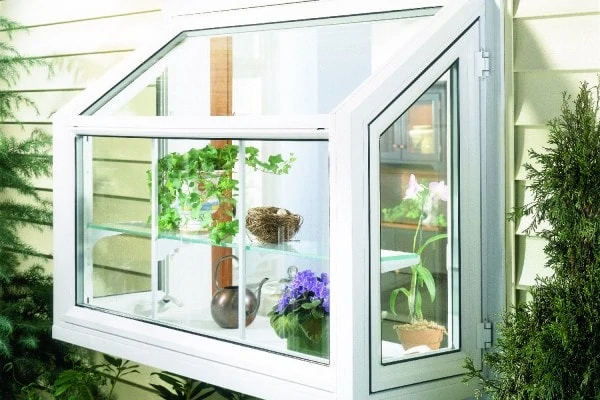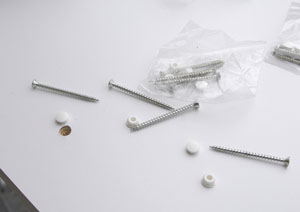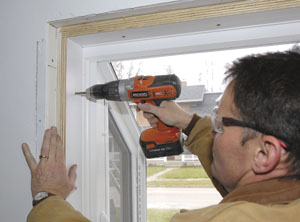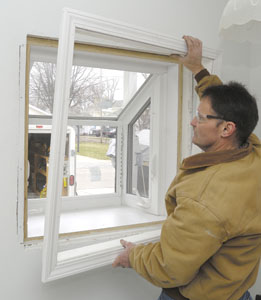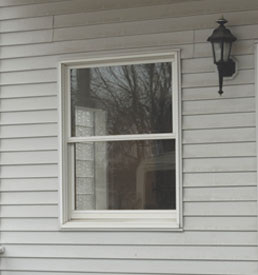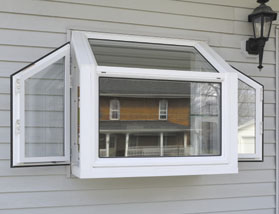Just because the temperatures are turning colder, there’s no reason to say farewell to your garden—just move it indoors. Adding a bumpout Garden Window to your home allows you to grow herbs and plants throughout the year. Not a gardener? Don’t worry, these cozy windows make the perfect napping area for the family cat or a showpieces site for displaying collectibles.
One of the best places to locate a Garden Window is in a kitchen. Oftentimes builders install a hard-to-reach double hung window over a kitchen sink. Because they can be difficult to operate in that location, homeowners don’t gain ventilation in the kitchen area. With operating casement sidelites that easily crank open to allow in air the Garden Window solves that problem.
Simonton Windows offers a Garden Window that’s easy to install as a do-it-yourself project and adds value to the home.

Measure Twice—Order Once
This simple installation project starts by gaining measurements of the rough opening so that you can order the Garden Window. If you’re replacing the existing window, take off the window’s casing trim. Then measure the top, middle and bottom of the opening from side-to-side and top-to-bottom. Also, measure the opening diagonally to ensure the area is square.
For a Garden Window, deduct 1/2″ in width and 1/2″h in height when ordering the unit. This will ensure a properly sized unit to fit your area. Next, measure the finished surfaces from the exterior to the interior wall using a combination square. You want to determine the maximum jamb depth to make sure the proper unit is ordered.
You’ll want t o note in your order if the window is for a new construction or a remodeling project. If you are ordering for a new construction option, flashing flanges come standard. If you’re installing this unit as a replacement unit, the flashing flanges may be ordered as an option if you believe you’ll need them for the project.
When placing the order with Simonton, make certain to specify if you want a white, oak or birch finish on the interior of the unit. You may also order an optional insulated sea board to place at the bottom of the unit which will help increase the R value of the window for cold climates. Instructions will arrive with the sat board for easy assembly and installation.
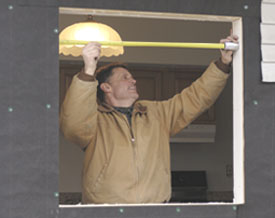
Inspecting the Window
After placing the window order and receiving the unit, carefully inspect the Garden Window. If you’re installing this unit as a replacement window, make sure to do this before removing the existing window. Double-check the dimensions of the unit to make sure they match up accurately with the dimensions ordered for the window.
Make certain you have received 12 screws with screw covers. You should also receive two brackets and a tempered glass shelf for the window. If you ordered the flashing flange, make sure you received the trim piece that will snap in at the top of the exterior of the unit to help prevent water infiltration.
If the checklist for your Garden Window comes up good, then move forwards and remove the existing window right down to the rough opening caused by rot before fitting the new window in place.

Dry Fitting the Unit
From the outside of the home, place a sturdy jack stand directly below the exterior of the rough opening. Make sure the stand is level with the bottom sill of the rough opening so that it can support the unit during installation.
Have two people dry fit the window into the opening, using the jack stand to help steady the unit. While one person remains outside, have another person go inside. Double-check to make sure the operable sidelites are fully operational and can easily open while the unit is dry fitted into the home.
Securing the Window
Still working with one person outside and one person inside (and using the jack stand for support), position the window and secure it with screws at the top of both sides of the interior of the Garden Window. Go approximately six inches down from the top of the window for installation of the initial screws.
As the screws are being installed, make sure the unit is flush to the interior. Pre-drilling the screw areas will make the installation go faster. With the initial screws in place, measure to ensure the Garden Window is plumb, level and square.
To check if the unit is plumb, place a level vertically on both the interior and face of the left and right jambs. If the bubble indicator is centered, the unit is plumb.
To check if the unit is level, place a level along the sill. If the bubble indicator is centered, the unit is level.
To check if the unit is square, measure the window frame diagonally. Measure from the top left corner of the frame to the bottom right corner, and from the top right to bottom left. If the measurements are equal, the window is square.
Once these measurements and verifications have been achieved, predrill all screw holes and shim all locations near the screws around the top and sides of the unit. Finally, install all screws. Three screws should be installed on each of the four sides of the unit.
Interior Installation
Once your screws are installed, the outdoor person’s job is done. The unit will support itself when the screws are firmly in place. Once again, before putting the screw covers on, check to make sure the unit is plumb, level and square. Next, trim off the shims flush to the wall.
To fill the gap around the unit, add fiberglass insulation, pushing it gently into place with a putty knife. Once the unit is installed, if you determine that the gap opening is less than 1/8-inch, you may choose to use sealant instead to fill the smaller air spaces. Add screw covers to the interior of the unit and gently tap each one into place with a mallet.
Exterior Finish Work
Moving to the outside of the home, remove the jack stand. If you have chosen to use the flashing flanges with this window, now is the time to apply a bead of sealant in the accessory track at the top of the unit running the width of the window. Place the accessory trim in the track and flush with the exterior wall. Tap into place with a mallet to create a firm fit that prevents water infiltration.
Add sealant around the remaining sides of the Garden Window. Use a putty knife to make sure all the areas are sealed off with the adhesive. If you are not using a flashing flange, simply use sealant around all four sides of the Garden Window.
Before
After
Final Trim Work
Back inside the home, add the casing trim around the interior of the window. Place the adjustable brackets into the openings and then add in the glass shelf. Note that the screens are removable from the inside for cleaning or clear views. And, the casement handles fold-in for easy access.
If you’re using the window for plants, make certain the seat board is protected from potential water spillage from plant containers that could potentially stain or damage the seat board. And, note that the maximum weight capacity on the glass shelf is eight pounds per square foot.
As a final note, make sure to leave the bar code labels in place on the interior of the window unit. The information contained on these labels comes in handy if you ever wish to replace a part.
Editor’s Note: For further information and installation instructions for Garden Windows, visit the Product Section at www.simonton.com.


